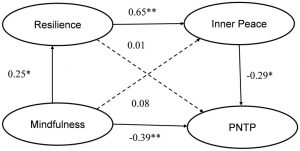Improve Well-Being and Relaxation of Patients Undergoing Rehabilitation for Acquired Brain Injuries with Yoga Practice
By John M. de Castro, Ph.D.
“One of the things about yoga that is different from traditional rehabilitation exercises is that it is more whole-body focused. It helps people learn to take their nervous systems to a more calm and relaxed state, which helps with healing.” –Kristine Miller
Brain damage is more or less permanent. The neurons and neural structures that are destroyed when the brain is damaged for the most part do not regrow. Brain Injury is caused by a number of different events from a violent blow to the head (Traumatic Brain Injury, TBI), to interruption of the blood supply to the brain (strokes), and to demyelinating diseases such as Multiple Sclerosis (MS). These neurological diseases are common and disabling. In the United States it is estimated that annually 1.7 million people sustain Traumatic Brain Injury, while 400,000 people are diagnosed with Multiple Sclerosis, and about 800,000 people have strokes.
Regardless of the cause, the brain is damaged, and the tissues that are destroyed are permanently lost. But we know that people can recover to some extent from brain injury. How is it possible that recovery can occur when there is no replacement of the damaged tissue? There appears to be a number of strategies that are employed by the brain to assist in recovery. Other areas of the brain can take over some of the function, other behavioral strategies can be employed to accomplish the task, and non-injured areas of the brain can adapt and change to compensate for the lost function.
Rehabilitation for brain injury patients usually involves strategies to promote these recovery mechanisms. Mindfulness training has been found to be helpful in recover from Traumatic Brain Injury, Multiple Sclerosis, and stroke. Yoga is both a mindfulness practice and an exercise making it a potentially ideal practice to promote rehabilitation from brain injury.
In today’s Research News article “The Lived Experience and Patient-reported Benefits of Yoga Participation in an Inpatient Brain Injury Rehabilitation Setting.” (See summary below or view the full text of the study at: https://www.ncbi.nlm.nih.gov/pmc/articles/PMC6937874/), Seeney and Griffin recruited adults with acquired brain injuries who were inpatients in a brain injury rehabilitation unit. They participated in once weekly 1-hour Hatha yoga classes that were modified for brain injury patients. They were measured before and after each yoga class for relaxation, well-being, and satisfaction with the class. After the second yoga class they completed a semi-structured interview on their lived experience while in rehabilitation.
They found that over each class and over the first 3 classes compared to baseline there were significant improvements in the relaxation and well-being of the patients. Qualitative analysis of the semi-structured interviews revealed that the participants found that participation in the yoga classes improved their levels of relaxation, their physical well-being including flexibility and movements, present moment awareness, and self-awareness.
Although this study was small, short-term, and lacked a control group, the results suggest that yoga training can be successfully implemented in a brain injury rehabilitation unit. It suggests that yoga practice is seen as beneficial by the patients with acquired brain injuries and it improved their well-being and relaxation. Although not investigated, it would be expected that this would improve their rehabilitation.
So, improve well-being and relaxation of patients undergoing rehabilitation for acquired brain injuries with yoga practice.
“A growing science is showing that the dynamic and multifaceted nature of yoga has tremendous potential to foster healing from brain injury. Not only does yoga offer a pathway to improved strength, attention control, and stress management, it can also provide people with powerful opportunities to look inward, connect with themselves more deeply, and discover their capacity to move forward.” – Kyla Pearce
CMCS – Center for Mindfulness and Contemplative Studies
This and other Contemplative Studies posts are also available on Google+ https://plus.google.com/106784388191201299496/posts and on Twitter @MindfulResearch
Study Summary
Seeney, R., & Griffin, J. (2020). The Lived Experience and Patient-reported Benefits of Yoga Participation in an Inpatient Brain Injury Rehabilitation Setting. International journal of yoga, 13(1), 25–31. https://doi.org/10.4103/ijoy.IJOY_46_19
Abstract
Context:
The multifactorial benefits of yoga have been well documented in the literature, with the integration of yoga therapy into healthcare being an emerging field. In general, yoga therapy programs are utilized in the community as an adjunct to other therapy. At present, limited rehabilitation units routinely incorporate integrative therapy options within a hospital environment.
Aims:
The aim of this study is to explore the lived experience and patient-reported benefits of yoga in an inpatient brain injury rehabilitation setting.
Settings and Design:
Thirty-one participants were recruited to the study after voluntarily participating in a yoga class within an inpatient brain injury rehabilitation unit of a major metropolitan hospital. Yoga sessions were held weekly for 60 min and consisted of a modified Hatha yoga style. This was a mixed-methods, quasi-experimental one-group pretest–posttest study.
Methodology:
Quantitative data were collected to measure perceptions of relaxation and well-being before and after yoga classes, along with the satisfaction of the class. Semi-structured interviews were utilized to collect qualitative data of experiences and perceptions associated with yoga participation.
Statistical Analysis Used:
Thematic analysis was completed for qualitative data. Quantitative data were analyzed using nonparametric statistical methods, and descriptive statistics were also provided.
Results:
The benefits described by participants are reported in this paper. These include improved relaxation, physical well-being, emotional well-being, being present, and self-awareness.
Conclusions:
This study describes the personal benefits experienced from regular yoga participation within an inpatient rehabilitation setting.
https://www.ncbi.nlm.nih.gov/pmc/articles/PMC6937874/







